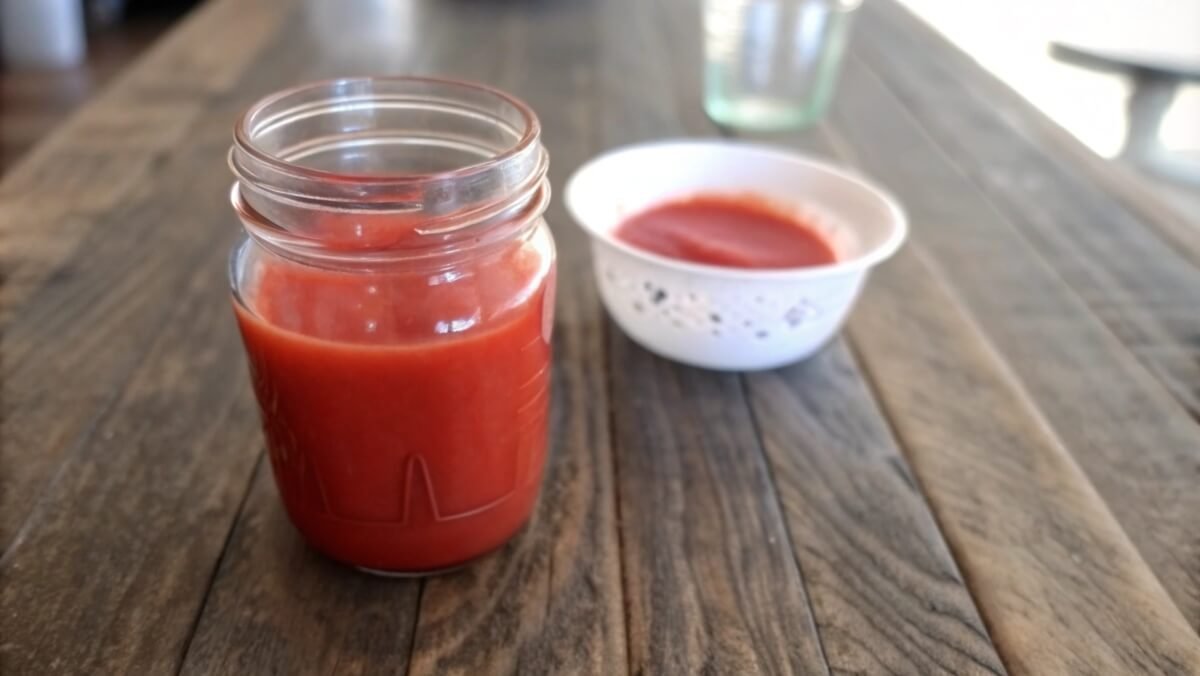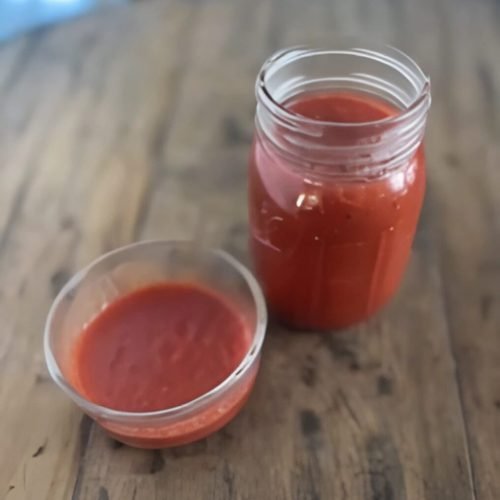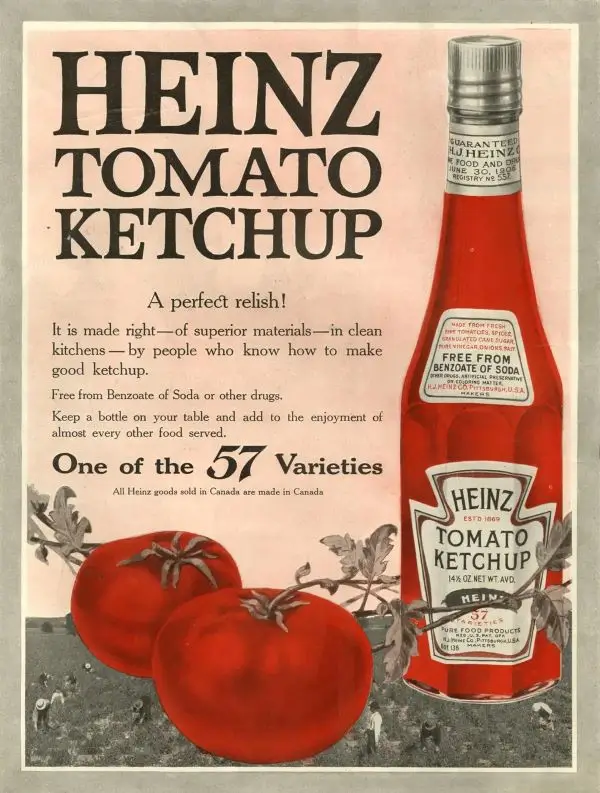DIY Homemade Ketchup Recipe (15 Minutes)
Ditch the Processed Stuff: Your Guide to Natural, Healthy Ketchup

In this post, you’ll discover how to make your own delicious, healthy ketchup at home without any “mysterious” ingredients or harmful additives.
We’ll look at why many store-bought ketchups might not be the best choice for your health, explore the fascinating history of this popular condiment, and learn a simple homemade ketchup recipe that you can make in your own kitchen.
Whether you’re concerned about the high fructose corn syrup in commercial brands or just want to try something new, this DIY homemade ketchup recipe will show you how easy it is to create a fresher, healthier version of everyone’s favorite sauce.
Homemade Ketchup Recipe
But first, here’s the recipe:

DIY Homemade Ketchup
Equipment
- 1 blender
- 1 saucepan
- 1 Stirring spoon
- 1 Jar for storage
Ingredients
- 1 can (28 oz) whole tomatoes
- 1/4 cup vinegar
- 1/4 cup honey
- 1/2 tsp onion powder
- 1/2 tsp garlic powder
- 1/2 tsp Celtic Sea Salt you can use Himalayan or Sea Salt as well
- 1/2 tsp black pepper
- 1/2 tsp paprika
Instructions
- Blend Tomatoes: Place the whole tomatoes in a blender and blend until smooth.
- Transfer to Saucepan: Pour the blended tomatoes into a saucepan.
- Add Ingredients: Add the vinegar, honey, onion powder, garlic powder, Celtic Sea Salt, black pepper, and paprika to the saucepan.
- Simmer: Stir the mixture well and bring it to a simmer over medium heat. Let it simmer for about 5 minutes, stirring occasionally.
- Cool and Store: Remove from heat and let it cool. Pour the ketchup into a jar and store it in the refrigerator.
Video
Notes
- Sweetener: You can substitute honey with maple syrup or agave nectar if desired.
- Spice Level: Adjust the amount of black pepper and paprika to suit your spice preference.
- Storage: This homemade ketchup can be stored in an airtight container in the refrigerator for up to 2 weeks.
- DIY Onion and Garlic Powder: For the best results, use homemade onion and garlic powder by dehydrating and grinding fresh onions and garlic.
Why Make Your Own Ketchup?
Let’s get real about what’s in your store-bought ketchup. Recent studies have uncovered some pretty shocking information about commercial ketchup that might make you think twice before reaching for that familiar bottle.
First, let’s talk about what’s actually in commercial ketchup. When you look at the ingredient list of leading brands, you’ll find:
- High fructose corn syrup (HFCS) AND corn syrup (yes, double the corn syrup!)
- “Natural flavoring” (which could mean almost anything)
- Various preservatives and additives

But here’s what’s really concerning: A recent investigation has revealed even more troubling facts about store-bought ketchup:
A recent investigation have discovered that over 65% of store-bought ketchup contains detectable levels of fluorine, which might indicate the presence of PFAS (often called “forever chemicals”).
These chemicals weren’t intentionally added – they likely got there during manufacturing. This is just one more reason why making your own ketchup is a smart choice.

The biggest issue with commercial ketchup is high fructose corn syrup (HFCS). Here’s why it’s problematic: [2]
- It’s made from genetically modified corn
- It can spike your blood sugar levels dramatically
- Research has linked it to several health concerns, including:
- Weight gain
- Increased risk of diabetes
- Potential liver problems
- Impact on learning and attention
- Other health issues
Furthermore, commercial ketchup often contains concerning levels of sugar and sodium. A single tablespoon [ketchup] can contain up to 4 grams of sugar – that’s about one teaspoon!
Additionally, most brands use chemical preservatives like sodium benzoate and potassium sorbate to extend shelf life. These additives have been linked to various health concerns, especially when consumed regularly.

In fact, the situation has become so concerning that some countries have taken action. While it’s not entirely accurate that ketchup is banned in France, there are strict regulations about serving it in French school cafeterias.
In 2011, France banned unlimited ketchup in school cafeterias to preserve French culinary culture and promote healthier eating habits among children. [3]
The Fascinating Origins of Ketchup
Surprisingly, ketchup wasn’t always the tomato-based condiment we know today. According to History.com, its story begins in ancient China, where it was known as “kê-tsiap” – a fermented fish sauce.
When British sailors discovered this savory condiment in the 17th century, they brought it back to England, where it underwent several transformations. Initially, English versions contained ingredients like mushrooms, walnuts, oysters, or anchovies – but no tomatoes!
The word itself evolved from the Hokkien Chinese word kê-tsiap, becoming “catchup” and eventually “ketchup” in English. [1]
The first known published recipe for tomato-based ketchup ,
The tomato-based ketchup we know today appeared in 1812 by James Mease in America. Henry J. Heinz ((yes, that Heinz!) is credited with creating the first commercial ketchup in 1876, which revolutionized the condiment industry. He introduced innovative production methods and was among the first to use preservatives to extend shelf life.

In different parts of the world, ketchup goes by various names: “catsup” in the Philippines, “ketjap” in Indonesia (though this refers to soy sauce), and “red sauce” in British English.
Each region has developed its own unique variations, reflecting local tastes and ingredients.
Why use Celtic Sea Salt instead of normal salt?
You might be wondering why our recipe specifically calls for Celtic Sea Salt instead of regular table salt. The reason is because Celtic Sea Salt is like the overachiever of the salt world.
While regular table salt is stripped of its natural minerals and often has additives, Celtic Sea Salt keeps all the good stuff:
- Contains over 80 natural minerals your body needs
- Harvested using traditional methods
- Has a more complex, interesting flavor
- Hasn’t been bleached or processed
- Contains no artificial additives
This makes it a perfect match for our healthier homemade ketchup!
To learn more about Celtic Sea Salt, you may want to check our comparison guide Himalayan Salt Vs Celtic Salt: Which Is Better.
What Other variations can you do?
Want to put your own spin on this basic recipe? Here are some exciting variations you might enjoy:
- Spicy Chipotle: Add 1-2 chipotle peppers in adobo sauce for a smoky kick
- Curry Ketchup: Include 1 tablespoon of curry powder for a German-inspired twist
- Roasted Garlic: Replace garlic powder with 4-5 roasted garlic cloves
- Balsamic: Substitute half the vinegar with balsamic vinegar for a richer flavor
- Low-Sugar: Use stevia or monk fruit sweetener instead of honey
Why ketchup should not be refrigerated
Contrary to popular belief, commercial ketchup doesn’t actually need refrigeration due to its high acidity and preservative content.
However, your homemade version is different.
Because it lacks artificial preservatives and has a higher moisture content, refrigeration is essential to prevent spoilage and maintain freshness.
Store it in an airtight container in the refrigerator, where it will keep well for up to two weeks. Remember to always use clean utensils when serving to extend its shelf life.
Bottom Line
By making your own ketchup, you’re avoiding more than just high fructose corn syrup. You’re also steering clear of potential exposure to PFAS chemicals, GMOs, and other concerning additives found in commercial versions.
While it might take a little more effort than grabbing a bottle off the store shelf, your health is worth it!
In the meantime, feel free to check more of our healthy recipes.
